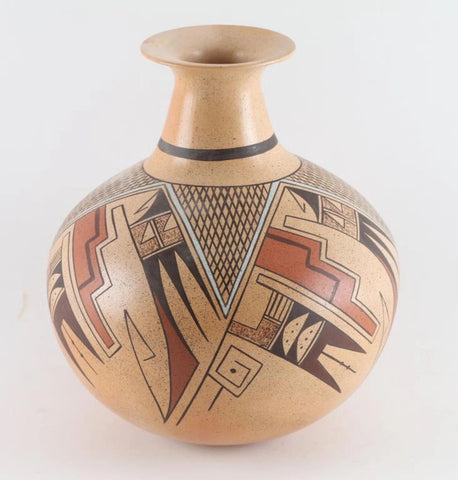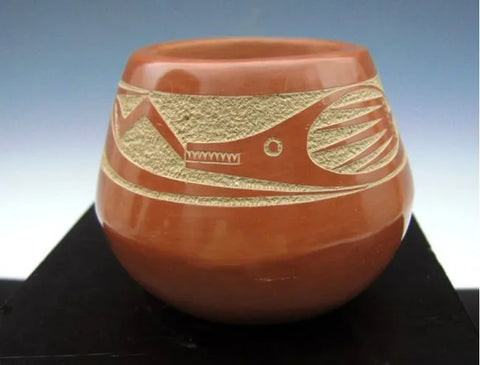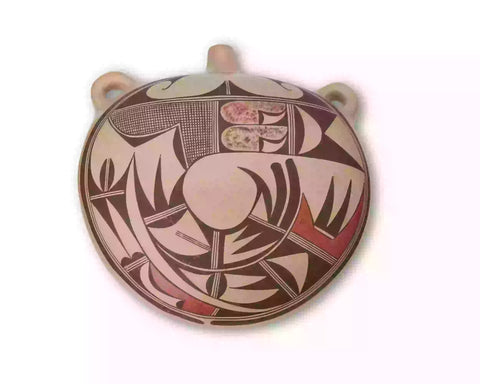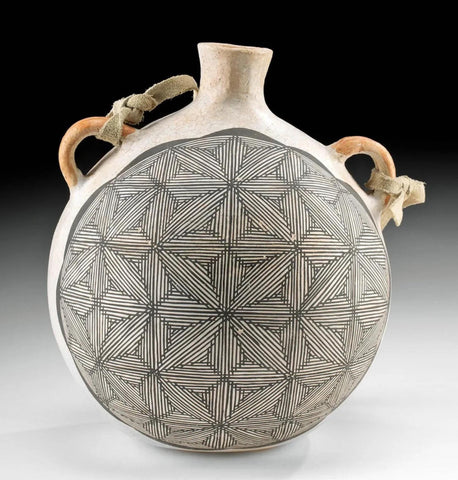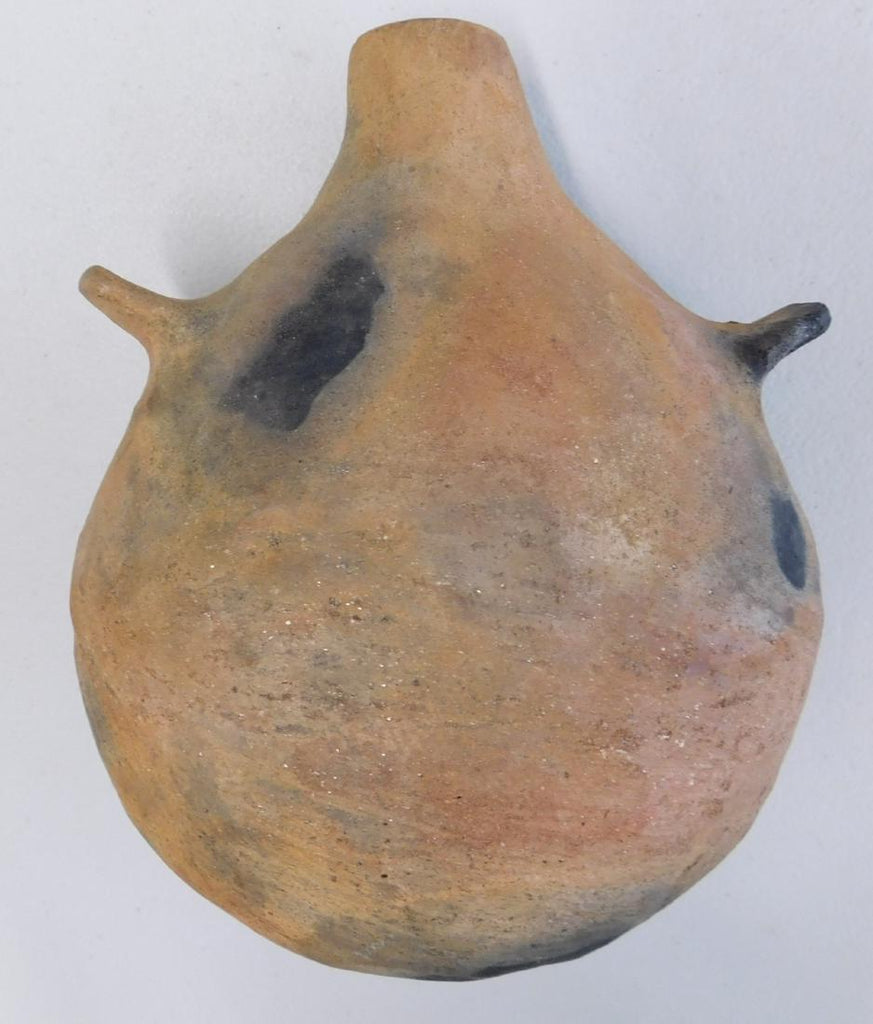
Native American Vintage Deguieno Potty Canteen, Ca 1940's, #1199
$ 800.00
Native American Deguieno Potty Canteen, Ca 1940's, #1199
Description: #1199 Native American Deguieno Potty Canteen, Ca 1940's, San Diego Deguieno Canteen, circa 1940's. Made of clay, Alpine, Calif. Has lugs for carrying
Dimensions: the item measures 6.5" x 4.5" x 8". .
Condition: Good, some wear, but overall very good for age
The Kumeyaay, also known as Tipai-Ipai, formerly Kamia or Diegueño, are Native American people of the extreme southwestern United States and northwest Mexico. They live in the states of California in the US and Baja California in Mexico. In Spanish, the name is commonly spelled Kumiai.
The Kumeyaay consist of two related groups, the Ipai and Tipai. The two coastal groups' traditional homelands were approximately separated by the San Diego River: the northern Ipai (extending from Escondido to Lake Henshaw) and the southern Tipai (including the Laguna Mountains, Ensenada, and Tecate).
Language
Nomenclature and tribal distinctions are not widely agreed upon. The general scholarly consensus (e.g., Langdon 1990) recognizes three separate languages: Ipai, Kumeyaay proper (including the Kamia), and Tipai in northern Baja California. Other authorities (e.g., Luomala 1978 and Pritzker 2000) see only two: Ipai and Tipai.
However, this notion is not supported by speakers of the language (actual Kumeyaay people) who contend that within their territory, all Kumeyaay (Ipai/Tipai) can understand and speak to each other, at least after a brief acclimatization period.[2] All three languages belong to the Delta–California branch of the Yuman language family, to which several other linguistically distinct but related groups also belong, including the Cocopa, Quechan, Paipai, and Kiliwa.
The term Kumeyaay means "those who face the water from a cliff".[3] Both "Ipai" and "Tipai" mean "people."[4] Some Kumeyaay in the southern areas also refer to themselves as MuttTipi, which means "people of the earth."[citation needed]
Linguist Margaret Langdon is credited with doing much of the early work on documenting the language.[5]
History
Engraving published by Schott, Sorony, and Co., 1857
Evidence of settlement, in what is today considered Kumeyaay territory, may go back 12,000 years.[6] 7000 BCE marked the emergence of two cultural traditions: the California Coast and Valley tradition and the Desert tradition.[7] The Kumeyaay had land extending from the Pacific Ocean to present Ensenada, Mexico, and then on east to the Colorado River and north to what is known as Oceanside.[citation needed] The Cuyamaca complex, a late Holocene complex in San Diego County is related to the Kumeyaay peoples.[8] The Kumeyaay tribe also used to inhabit what is now a popular state park, known as Torrey Pines State Natural Reserve.[9]
One view holds that historic Tipai-Ipai emerged around 1000 years ago, though a "proto-Tipai-Ipai culture" had been established by about 5000 BCE.[1] Katherine Luomola suggests that the "nucleus of later Tipai-Ipai groups" came together around AD 1000.[7] The Kumeyaay themselves believe that they have lived in San Diego for 12,000 years.[10] At the time of European contact, Kumeyaay comprised several autonomous bands with 30 patrilineal clans.[4]
Spaniards entered Tipai-Ipai territory in the late 18th century, bringing with them non-native, invasive flora, and domestic animals, which brought about degradation to local ecology. Under the Spanish Mission system, bands living near Mission San Diego de Alcalá, established in 1769, were called Diegueños.[4] After Mexico took over the lands from Spain, they secularized the missions in 1834, and Ipai and Tipais lost their lands; band members had to choose between becoming serfs, trespassers, rebels, or fugitives.[11]
From 1870 to 1910, American settlers seized lands, including arable and native gathering lands. In 1875, President Ulysses Grant created reservations in the area, and additional lands were placed under trust patent status after the passage of the 1891 Act for the Relief of Mission Indians. The reservations tended to be small and lacked adequate water supplies.[12]
Kumeyaay people supported themselves by farming and agricultural wage labor; however, a 20-year drought in the mid-20th century crippled the region's dry farming economy.[13] For their common welfare, several reservations formed the non-profit Kumeyaay, Inc.[14]
Shawii is the name of the mush of acorn that was eaten daily by Kumeyaay .[15]
Education
The Kumeyaay Community College was created by the Sycuan Band to serve the Kumeyaay-Diegueño Nation, and describes its mission as "to support cultural identity, sovereignty, and self-determination while meeting the needs of native and non-Native students." The college's focus is on "Kumeyaay History, Kumeyaay Ethnobotany and traditional Indigenous arts." It "serves and relies on resources from the thirteen reservations of the Kumeyaay Nation situated in San Diego county."[16]
Population]
Further information: Population of Native California
Estimates for the pre-contact populations of most native groups in California have varied substantially. In 1925, Alfred L. Kroeber proposed that the population of the Kumeyaay in the San Diego region in 1770 had been about 3,000.[17] More recently, Katharine Luomala points out that this estimate depended on calculations of rates of baptisms at the Mission, and as such "ignores the unbaptized." She suggests that the region could have supported 6,000-9,000 people.[18] Florence C. Shipek goes further, estimating 16,000-19,000 inhabitants.[19]
In the late eighteenth century, it is estimated that the Kumeyaay population was between 3,000 and 9,000.[1] In 1828, 1,711 Kumeyaay were recorded by the missions. The 1860 federal census recorded 1,571 Kumeyaay living in 24 villages.[18] The Bureau of Indian Affairs recorded 1,322 Kumeyaay in 1968, with 435 living on reservations.[18] By 1990, an estimated 1,200 lived on reservation lands, while 2,000 lived elsewhere.[1]
Tribes and reservations]
Kumeyaay coiled basket, woven by Celestine Lachapa, 19th century, San Diego Museum of Man
Kumeyaay willow storage basket at the Universidad Autónoma de Baja California cultural museum, Mexicali
The Kumeyaay live on 13 reservations in San Diego County, California in the United States and are enrolled in the following federally recognized tribes:[20]
Campo Band of Diegueno Mission Indians of the Campo Indian Reservation
Capitan Grande Band of Diegueno Mission Indians of California:
Barona Group of Capitan Grande Band of Mission Indians of the Barona Reservation
Viejas (Baron Long) Group of Capitan Grande Band of Mission Indians of the Viejas Reservation
Ewiiaapaayp Band of Kumeyaay Indians
(formerly the Cuyapaipe Community of Diegueno Mission Indians of the Cuyapaipe Reservation)
Inaja Band of Diegueno Mission Indians of the Inaja and Cosmit Reservation
Jamul Indian Village of California
La Posta Band of Diegueno Mission Indians of the La Posta Indian Reservation
Manzanita Band of Diegueno Mission Indians of the Manzanita Reservation
Mesa Grande Band of Diegueno Mission Indians of the Mesa Grande Reservation
San Pasqual Band of Diegueno Mission Indians of California
Iipay Nation of Santa Ysabel (formerly Santa Ysabel Band of Diegueno Mission Indians of the Santa Ysabel Reservation)
Sycuan Band of the Kumeyaay Nation
They live on five communities in Baja California, including:
Juntas de Neji
La Huerta
San Antonio Necua
Santa Catarina
San José de la Zorra.[10]
(Source Wikipedia)
Description: #1199 Native American Deguieno Potty Canteen, Ca 1940's, San Diego Deguieno Canteen, circa 1940's. Made of clay, Alpine, Calif. Has lugs for carrying
Dimensions: the item measures 6.5" x 4.5" x 8". .
Condition: Good, some wear, but overall very good for age
The Kumeyaay, also known as Tipai-Ipai, formerly Kamia or Diegueño, are Native American people of the extreme southwestern United States and northwest Mexico. They live in the states of California in the US and Baja California in Mexico. In Spanish, the name is commonly spelled Kumiai.
The Kumeyaay consist of two related groups, the Ipai and Tipai. The two coastal groups' traditional homelands were approximately separated by the San Diego River: the northern Ipai (extending from Escondido to Lake Henshaw) and the southern Tipai (including the Laguna Mountains, Ensenada, and Tecate).
Language
Nomenclature and tribal distinctions are not widely agreed upon. The general scholarly consensus (e.g., Langdon 1990) recognizes three separate languages: Ipai, Kumeyaay proper (including the Kamia), and Tipai in northern Baja California. Other authorities (e.g., Luomala 1978 and Pritzker 2000) see only two: Ipai and Tipai.
However, this notion is not supported by speakers of the language (actual Kumeyaay people) who contend that within their territory, all Kumeyaay (Ipai/Tipai) can understand and speak to each other, at least after a brief acclimatization period.[2] All three languages belong to the Delta–California branch of the Yuman language family, to which several other linguistically distinct but related groups also belong, including the Cocopa, Quechan, Paipai, and Kiliwa.
The term Kumeyaay means "those who face the water from a cliff".[3] Both "Ipai" and "Tipai" mean "people."[4] Some Kumeyaay in the southern areas also refer to themselves as MuttTipi, which means "people of the earth."[citation needed]
Linguist Margaret Langdon is credited with doing much of the early work on documenting the language.[5]
History
Engraving published by Schott, Sorony, and Co., 1857
Evidence of settlement, in what is today considered Kumeyaay territory, may go back 12,000 years.[6] 7000 BCE marked the emergence of two cultural traditions: the California Coast and Valley tradition and the Desert tradition.[7] The Kumeyaay had land extending from the Pacific Ocean to present Ensenada, Mexico, and then on east to the Colorado River and north to what is known as Oceanside.[citation needed] The Cuyamaca complex, a late Holocene complex in San Diego County is related to the Kumeyaay peoples.[8] The Kumeyaay tribe also used to inhabit what is now a popular state park, known as Torrey Pines State Natural Reserve.[9]
One view holds that historic Tipai-Ipai emerged around 1000 years ago, though a "proto-Tipai-Ipai culture" had been established by about 5000 BCE.[1] Katherine Luomola suggests that the "nucleus of later Tipai-Ipai groups" came together around AD 1000.[7] The Kumeyaay themselves believe that they have lived in San Diego for 12,000 years.[10] At the time of European contact, Kumeyaay comprised several autonomous bands with 30 patrilineal clans.[4]
Spaniards entered Tipai-Ipai territory in the late 18th century, bringing with them non-native, invasive flora, and domestic animals, which brought about degradation to local ecology. Under the Spanish Mission system, bands living near Mission San Diego de Alcalá, established in 1769, were called Diegueños.[4] After Mexico took over the lands from Spain, they secularized the missions in 1834, and Ipai and Tipais lost their lands; band members had to choose between becoming serfs, trespassers, rebels, or fugitives.[11]
From 1870 to 1910, American settlers seized lands, including arable and native gathering lands. In 1875, President Ulysses Grant created reservations in the area, and additional lands were placed under trust patent status after the passage of the 1891 Act for the Relief of Mission Indians. The reservations tended to be small and lacked adequate water supplies.[12]
Kumeyaay people supported themselves by farming and agricultural wage labor; however, a 20-year drought in the mid-20th century crippled the region's dry farming economy.[13] For their common welfare, several reservations formed the non-profit Kumeyaay, Inc.[14]
Shawii is the name of the mush of acorn that was eaten daily by Kumeyaay .[15]
Education
The Kumeyaay Community College was created by the Sycuan Band to serve the Kumeyaay-Diegueño Nation, and describes its mission as "to support cultural identity, sovereignty, and self-determination while meeting the needs of native and non-Native students." The college's focus is on "Kumeyaay History, Kumeyaay Ethnobotany and traditional Indigenous arts." It "serves and relies on resources from the thirteen reservations of the Kumeyaay Nation situated in San Diego county."[16]
Population]
Further information: Population of Native California
Estimates for the pre-contact populations of most native groups in California have varied substantially. In 1925, Alfred L. Kroeber proposed that the population of the Kumeyaay in the San Diego region in 1770 had been about 3,000.[17] More recently, Katharine Luomala points out that this estimate depended on calculations of rates of baptisms at the Mission, and as such "ignores the unbaptized." She suggests that the region could have supported 6,000-9,000 people.[18] Florence C. Shipek goes further, estimating 16,000-19,000 inhabitants.[19]
In the late eighteenth century, it is estimated that the Kumeyaay population was between 3,000 and 9,000.[1] In 1828, 1,711 Kumeyaay were recorded by the missions. The 1860 federal census recorded 1,571 Kumeyaay living in 24 villages.[18] The Bureau of Indian Affairs recorded 1,322 Kumeyaay in 1968, with 435 living on reservations.[18] By 1990, an estimated 1,200 lived on reservation lands, while 2,000 lived elsewhere.[1]
Tribes and reservations]
Kumeyaay coiled basket, woven by Celestine Lachapa, 19th century, San Diego Museum of Man
Kumeyaay willow storage basket at the Universidad Autónoma de Baja California cultural museum, Mexicali
The Kumeyaay live on 13 reservations in San Diego County, California in the United States and are enrolled in the following federally recognized tribes:[20]
Campo Band of Diegueno Mission Indians of the Campo Indian Reservation
Capitan Grande Band of Diegueno Mission Indians of California:
Barona Group of Capitan Grande Band of Mission Indians of the Barona Reservation
Viejas (Baron Long) Group of Capitan Grande Band of Mission Indians of the Viejas Reservation
Ewiiaapaayp Band of Kumeyaay Indians
(formerly the Cuyapaipe Community of Diegueno Mission Indians of the Cuyapaipe Reservation)
Inaja Band of Diegueno Mission Indians of the Inaja and Cosmit Reservation
Jamul Indian Village of California
La Posta Band of Diegueno Mission Indians of the La Posta Indian Reservation
Manzanita Band of Diegueno Mission Indians of the Manzanita Reservation
Mesa Grande Band of Diegueno Mission Indians of the Mesa Grande Reservation
San Pasqual Band of Diegueno Mission Indians of California
Iipay Nation of Santa Ysabel (formerly Santa Ysabel Band of Diegueno Mission Indians of the Santa Ysabel Reservation)
Sycuan Band of the Kumeyaay Nation
They live on five communities in Baja California, including:
Juntas de Neji
La Huerta
San Antonio Necua
Santa Catarina
San José de la Zorra.[10]
(Source Wikipedia)
Related Products
Sold out
Sold out




